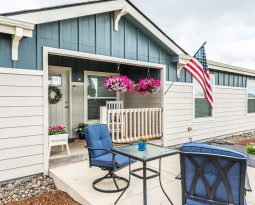Real Estate Experts Acknowledge the Advantages of Factory Built Housing
In 2019, an (M.H.I.) report stated the average per square foot cost for a new site-built home was $111, compared to a new manufactured home at $50 per square foot – with the average sales price of a new manufactured in 2019 was less than $80,000, (not including land), compared to a typical site-built average price of $330,000 on a U.S. home, according to May 2020 Realtors.com data.
In a recent report via Yahoo! Finance, real estate experts acknowledge the role of manufactured housing in serving the nation’s affordable housing needs, noting that the factory-built housing industry (manufactured and modular homes) has grown over 34% since 2015, according to Census data.
Price advantages prompted the U.S. Housing and Urban Development Secretary Ben Carson to make manufactured and modular homes a major agenda item during his term. Carson prescribed the deregulation of manufactured housing as a solution to America’s affordable housing crisis during his “Driving affordable housing across America” bus tour early this year.
“Today we’re proposing changes that remove more of the red tape that stands between the production of safe, quality homes and the nation’s families and individuals that need these homes to make homeownership a reality,” said Carson at a Clayton Homes manufactured housing factory in Russelville, Alabama in February.
‘Pandemic will nudge builders toward modularization’
“I’m watching new technologies – panel construction – modular housing..there are some interesting things that are happening in the construction industry that are driving down costs,” said Byron Carlock, a U.S. real estate practice leader of London-based professional services network PwC, with it’s “Emerging Trends In Real Estate 2021 Survey Report.”
The site home building industry was already ripe for change before the coronavirus pandemic. Construction has suffered a labor shortage since the Great Recession of 2008, and labor costs, material costs, and labor availability were still the top three developer complaints in 2020, according to PwC. But manufactured construction allows companies to build houses where labor and supplies are most accessible.
“I think with more prefabrications, trying to do more in a controlled environment, in a shop, some companies are working towards that and less on-the-job work, [They’re] more in control in the factory,” said Larrett LiLBuono, a consultant at New York-based CREtech Global Innovation Consulting Practice at the CREtech consulting talk webinar on October 20.
The coronavirus pandemic only added to the practicality of moving construction indoors, where processes are systemized and often automated. Thousands of construction projects were delayed during the pandemic because of disrupted supply chains, regulatory shutdowns, and continuing labor shortages – delays that could have been mitigated in a controlled environment, according to analysts.
“The coronavirus pandemic will likely nudge firms toward modularization and prefabrication of components. Assembly line efficiency and the controlled environment of a construction “factory floor” can bring cost savings with higher efficiencies in labor productivity and shortened project schedules,” said the Deloitte 2020 engineering and construction industry outlook.
For more information, click our recent posting, “New Manufactured Home Sales Boom In Difficult Times.”







